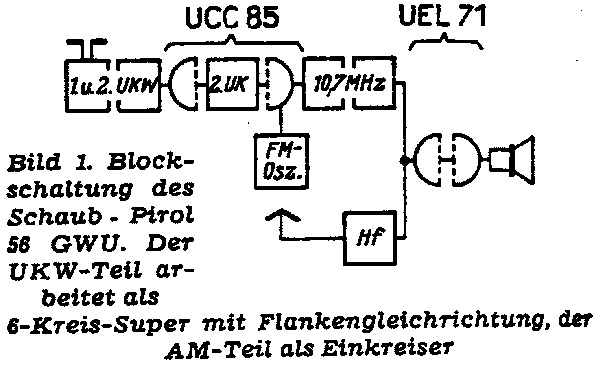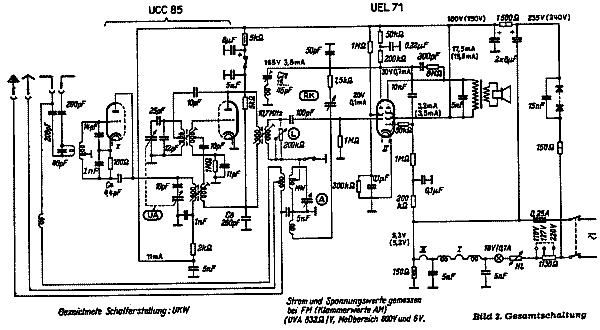schaub: Schaub Pirol AM-FM introduced in Funkschau 1955
schaub: Schaub Pirol AM-FM introduced in Funkschau 1955
Fellow Radiophiles, this set was introduced by Funkschau in 1955.
Regards,
-Joe
Funkschau 1955, volume 9, page 194.
Interesting designs: A small FM superheterodyne set
The inexpensive single tuned circuit AM set keeps loosing its reason to exist because it can't receive FM broadcasts. Super-regenerative FM receivers are discontinued due to their unpleasant radiated interference. The Schaub Pirol 56 GWU was created for the low end of the superheterodyne price range. It operates with a single tuned circuit in the AM band and uses 6 tuned circuits for FM. Figure 1 shows the block diagram.

The low cost of 109 DM, which exceeds the price of a single tuned circuit AM radio by only about 40 DM, is realized by using a mass produced FM front end building block that is also used in the standard sized FM receivers from this year's production cycle. This front end block does the RF preamplification, frequency conversion and IF amplification with six tuned circuits: An input FM bandpass filter, a tuned tank load at the RF preamp anode, a tuned oscillator tank, and both tuned tank circuits of the IF bandpass filters. This block uses the series string heater UCC85.
The FM input filter provides wide band pre-selection and IF stability. Oscillator leakage is also blocked from the antenna, so that the “Bundespost” regulations can be easily met. The RF preamp is realized with an intermediate grounding scheme (“Zwischenbasis”). (Figure 2)

The intermediate grounding circuit grounds the input coil at a tap point to achieve high gain with uncritical neutralization (C4=4.4pF from the Anode to the input coil). At resonance, the tunable anode circuit has a resistance around 10kW to yield amplification around 60-fold.
The second triode works as a self-oscillating additive mixer. The RF signal is fed into the grid coil of the oscillator. The internal resistance of the triode is increased by regenerative feedback (voltage drop across C8=260pF) at IF frequencies. The IF bandpass filter drives the grid-leak tetrode detector in the UEL71, which operates as a slope detector. The IF filter secondary is loaded by a 200kW volume control. The value of this resistor is reduced to lower the volume from strong stations. This reduced resistance dampens the IF filter, widens the IF bandwidth and the slope detection becomes more linear with a resulting increase in sound reproduction quality. A preset regenerative feedback from the grid-leak detector anode via capacitor C22 increases FM sensitivity to 80uV for an output power of 50mW with 22.5kHz(rms) FM deviation. Thus is the goal of this receiver achieved, which is to receive local FM stations.
The AM section is implemented with a single tuned circuit with variable antenna coupling and regenerative grid leak detector. The Lorenz UEL71 dual is applied here for the detector tube and output tube. The grid bias for the output tube is taken across the 150W resistor in the power supply circuit and is filtered with 200kW and 0.1uF.
A small amount of negative feedback from the anode of the output tube to the anode of the grid-leak detector (8MW, 300pF) yields a bass boost. Just two 8uF capacitors and a 1.5kW resistor are enough to filter the low current that is drained by the anode circuits. The small heater voltage drop for both tubes makes 110V AC/DC operation possible, which includes a dial lamp that is protected by an additional current surge limiting resistor.
Despite the added FM section, the construction of the chassis in this receiver takes hardly more effort than that of a simple single tuned AM radio.
Translated by Joe Sousa from a scan kindly provided by Mr. Eckhard Kull and posted in the original German by Prof. Dietmar Rudolph at
Die interessante Schaltung: Ein UKW-Kleinsuper.
To thank the Author because you find the post helpful or well done.
